Apply now to join our next cohort of Community Science Fellows and Community Leads!
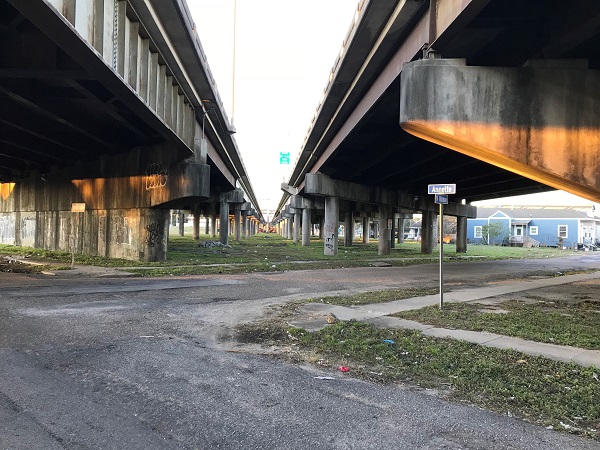
The Team
Amy Stelly, Claiborne Ave. Alliance, [email protected]
Emily Gaddis, Claiborne Ave. Alliance
Adrienne Katner, Louisiana State University School of Public Health, [email protected]
Kari Brisolara, Louisiana State University School of Public Health
Results
The focus of the Claiborne Ave., New Orleans project was to characterize environmental hazards, exposures, potential health implications and traffic-associated health outcomes for the communities living around Interstate I-10 (also referred to as the I-10 corridor).
In their final report, linked below, LSU’s Public Health team found that residents living in the I-10 corridor are in the top 95th to 100th percentile in the state in terms of traffic proximity. In the Summary of Results on pages 6-8, the team outlines the following:
Methods
To prioritize traffic-related environmental issues of concern in the I-10 Corridor area, scientific literature was reviewed to identify traffic-associated pollutants, exposure levels of concern (traffic volume, interstate proximity and air pollutant concentrations), and adverse health outcomes that are significantly related to interstate traffic and automobile emissions.
Multiple site visits were conducted to measure noise, air concentrations of particulate matter and to document potential exposure routes. Monitoring and emissions modeling data for the area from multiple third-party sources were requested and/or summarized. Hazard monitoring data were reviewed to identify those occurring at levels that exceed health-based standards; health outcome statistics for the community in zip codes adjacent to the site were also reviewed to identify areas with rates of adverse health outcomes occurring at rates exceeding state values. Land use recommendations were evaluated and discussed within the context of their potential implications on the prevailing environmental, exposure and health conditions.
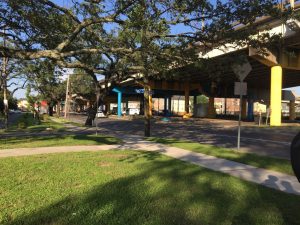 Estimates of interstate proximity were conducted using Google Earth distance measurement tool. Measurements were made in meters to enable comparison with proximities reported in the literature. Interstate traffic volume estimates were obtained from the LA Department of Transportation (LDOT). Air concentrations, either measured of modeled, were derived from either the US EPA or the LA Department of Environmental Quality (LDEQ) databases. These site-specific “exposure” measures were then compared to those measures in the literature that were found to be significantly associated with traffic-related health impacts, and available health-based standards. Health risks or hazard index estimates derived from federal studies of site-specific traffic-related emissions modeling were also evaluated to flag health conditions of potential concern.
Estimates of interstate proximity were conducted using Google Earth distance measurement tool. Measurements were made in meters to enable comparison with proximities reported in the literature. Interstate traffic volume estimates were obtained from the LA Department of Transportation (LDOT). Air concentrations, either measured of modeled, were derived from either the US EPA or the LA Department of Environmental Quality (LDEQ) databases. These site-specific “exposure” measures were then compared to those measures in the literature that were found to be significantly associated with traffic-related health impacts, and available health-based standards. Health risks or hazard index estimates derived from federal studies of site-specific traffic-related emissions modeling were also evaluated to flag health conditions of potential concern.
To assess ambient particulate matter (PM) levels, the team conducted limited monitoring of particulate matter (PM) levels within the Claiborne Corridor- either directly under the overpass, across the street, and at some further distance to evaluate proximity impacts on PM levels. To conduct the particulate air monitoring assessment, a Dylos DC 1170 air quality monitor was used.
Available disease rate data for this area were obtained from various health surveillance databases and compared to the list of flagged priority traffic-related emissions and associated health outcomes. Site-specific disease rates which exceeded rates of the city, state or nation were identified as having a potential association with current traffic conditions.
Land use scenarios and their impacts on traffic were derived from the Livable Claiborne Corridor study (LCC). Impacts on all traffic and diesel-related traffic were considered as the driving factor in charactering the potential impact of each scenario on environmental and health conditions for the area (see Appendix C for reports reviewed). Recommendations to reduce contaminant exposures were derived from prevailing public health guidelines.
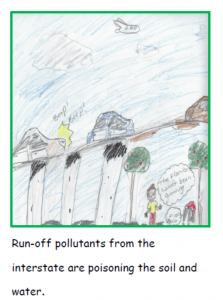 Towards the end of the project, Amy Stelly visited the 4th grade students at Phillis Wheatley Community School to conduct some environmental monitoring of the air and water. Together, with Thriving Earth Exchange partner, Public Lab, the students launched a weather balloon to collect some aerial photos of the corridor. The students were assigned to reflect on the day and note what they experienced and how they felt about the activities. Amy made sure to visit the classroom ahead of the field day to talk to the students about the history of the I-10 corridor. As a result of their interactions and field day launching a balloon, the students produced a children’s book where they wrote and illustrated their experiences.
Towards the end of the project, Amy Stelly visited the 4th grade students at Phillis Wheatley Community School to conduct some environmental monitoring of the air and water. Together, with Thriving Earth Exchange partner, Public Lab, the students launched a weather balloon to collect some aerial photos of the corridor. The students were assigned to reflect on the day and note what they experienced and how they felt about the activities. Amy made sure to visit the classroom ahead of the field day to talk to the students about the history of the I-10 corridor. As a result of their interactions and field day launching a balloon, the students produced a children’s book where they wrote and illustrated their experiences.
Project Outputs:
Katner A, LeCompte E, Stallard C, Wash I, Stelly, A, Gaddis, E, Brisolara K. Traffic-Related Pollutants and Human Health within the I-10 Claiborne Corridor, New Orleans, LA: Land Use Implications. Report presented to the Claiborne Avenue Alliance, the American Geophysical Union’s Thriving Earth Exchange Program and the New Orleans City Council. (April 2019). Louisiana State University School of Public Health, New Orleans, LA.
Reflections
From this project, others may learn better ways to partner with Thriving Earth Exchange for their own purposes. For instance,
The team noted that the following contributed to the success of the project:
However, there were a few key things that the team would do differently if they had the chance to do this project again:
To other teams currently pursuing Thriving Earth Exchange projects and for those that anticipate doing a Thriving Earth Exchange project, the team recommends:
The Claiborne Corridor in New Orleans, Louisiana, is a network of neighborhoods surrounding Claiborne Avenue, a major thoroughfare running more than 9 miles through the city center. It extends from Jefferson Parish in the west to St. Bernard Parish in the east and encompasses a number of predominantly African American communities, including the nation’s oldest, Tremé. In the late 1960s, Interstate 10 was constructed above the central segment of Claiborne Avenue in and around Tremé. The impacts of I-10 on neighboring communities since that time have been far-reaching. The physical division of previously connected neighborhoods and the removal of businesses along what used to be a commercial artery have fragmented the community socially, culturally, and economically. Today, poverty and crime are disproportionately experienced by residents of the Claiborne Corridor, and reliable access to jobs, housing, and transportation remains a challenge.
Claiborne Avenue Alliance is a coalition of local residents and business owners whose aim is to “reclaim, restore, and rebuild” communities along the Claiborne Corridor that have been negatively impacted by the construction of I-10. The environmental and health impacts of I-10’s presence are a key concern that motivates their engagement with TEX. Air pollution from vehicle emissions is a particular concern, and residents near the interstate note that particulates visibly coat the walls of homes and businesses. Noise and light pollution associated with vehicle traffic compound potential health effects. Moreover, the removal and paving over of historic green spaces along the corridor have exacerbated the impacts of local flooding, with consequences for water quality, ease of local transportation, use of outdoor spaces, etc.
Despite efforts to raise residents’ concerns via position statements, media engagement, and discussions with local authorities, Claiborne Avenue Alliance feels that the community’s voice is not being fully heard by decision makers. They believe their voice would be amplified and residents empowered by a comprehensive, data-driven documentation of the environmental and health impacts of the I-10 corridor. While some such data already exist, these are spread across multiple sources, and the cumulative effects of multiple environmental stressors is not easily communicated. These concerns are set against the backdrop of the upcoming New Orleans Tricentennial and associated plans by local authorities to revitalize Claiborne Avenue, which present both challenges and opportunities.
Claiborne Avenue Alliance seeks support to mine, compile, and interpret existing data documenting the environmental impacts of the I-10 corridor on the health and well-being of local residents, and to communicate these impacts to relevant parties. They are especially interested in scenario modelling as a means of communicating the cumulative impacts of I-10 in its current state, as well as scenarios that model alternative, improved visions of the future of the Claiborne Corridor (e.g., with new environmental safeguards in place). In their own words, “We want to be able to effectively communicate our experience [of living with the I-10 corridor] and our vision [of what Claiborne could be].” This work would culminate in a community forum bringing together residents, decision makers, media, and other stakeholders. The aim of this forum is to engage all parties in a collective vision, supported by science, visualized via scenario modeling, and communicated in creative and digestible ways. Specifically, the groups hopes this work will:
During AGU’s 2021 Fall Meeting in New Orleans, we were honored to meet many community members who are working to make the region’s neighborhoods healthier, more connected and more resilient. Here’s a glimpse of what we saw.
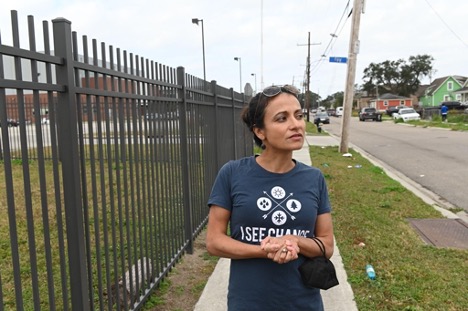 Community lead Julia Kumari Drapkin stands in front of a football field in Gentilly, now the site of a water retention project. The community-sourced data from the Gentilly Thriving Earth Exchange project was a catalyst that resulted in remodeling and reallocation of $4.8 million in flood mitigation to the St. Bernard Campus in Gentilly. The underground unit was expanded by 2.5x, storing up to 5 million gallons of stormwater in underground detention basins – the largest of its kind in the South.
Community lead Julia Kumari Drapkin stands in front of a football field in Gentilly, now the site of a water retention project. The community-sourced data from the Gentilly Thriving Earth Exchange project was a catalyst that resulted in remodeling and reallocation of $4.8 million in flood mitigation to the St. Bernard Campus in Gentilly. The underground unit was expanded by 2.5x, storing up to 5 million gallons of stormwater in underground detention basins – the largest of its kind in the South.
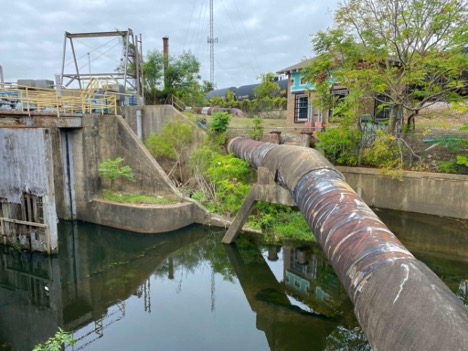 A view of Pumping Station No. 3 in the 7th Ward. Flood control infrastructure is critical in New Orleans 24/7 – there’s someone on the job at every pumping station in the city at all hours, every day, 365 days a year. Here, we see the canal and the transfer pipe that moves water out of the neighborhood and pumps it to Lake Pontchartrain.
A view of Pumping Station No. 3 in the 7th Ward. Flood control infrastructure is critical in New Orleans 24/7 – there’s someone on the job at every pumping station in the city at all hours, every day, 365 days a year. Here, we see the canal and the transfer pipe that moves water out of the neighborhood and pumps it to Lake Pontchartrain.
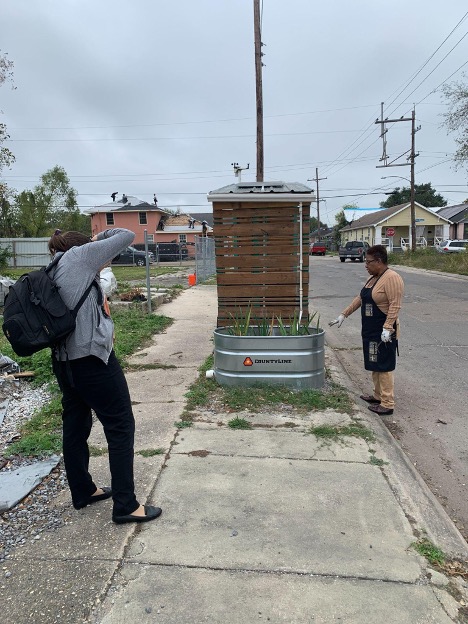 AGU Design director Beth Bagley photographs Angela Chalk, founder of Healthy Community Services, in front of a bus shelter designed with a slanted roof and rain garden to reduce flooding. It also includes a solar-powered charging station that residents can use to power up electronics – a valuable resource if power is lost due to hurricanes or other climate catastrophes. Angela Chalk served as community lead on a Thriving Earth project on monitoring the effects of greening on the urban heat island effect, water uptake, and social challenges and is serving as a Community Science Fellow on a new project in the 7th Ward.
AGU Design director Beth Bagley photographs Angela Chalk, founder of Healthy Community Services, in front of a bus shelter designed with a slanted roof and rain garden to reduce flooding. It also includes a solar-powered charging station that residents can use to power up electronics – a valuable resource if power is lost due to hurricanes or other climate catastrophes. Angela Chalk served as community lead on a Thriving Earth project on monitoring the effects of greening on the urban heat island effect, water uptake, and social challenges and is serving as a Community Science Fellow on a new project in the 7th Ward.
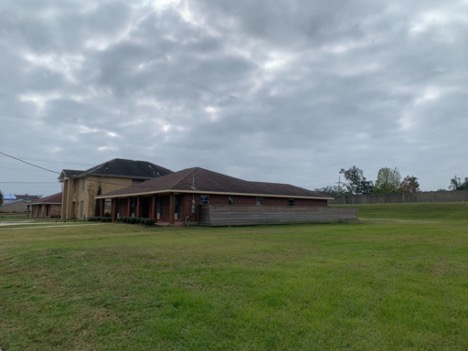 The Flooded House Museum at the breach site of the London Avenue Canal flood wall is a sobering reminder of the impacts of Hurricane Katrina. During the storm, the house was pushed across the street and turned around 180 degrees. Today, it has been returned to its original plot, and is preserved as a museum where visitors can look in through storm windows to see how the hurricane devastated its interior. The London Avenue Canal’s flood wall can be seen in the background; the wall was breached just yards from where the house stood.
The Flooded House Museum at the breach site of the London Avenue Canal flood wall is a sobering reminder of the impacts of Hurricane Katrina. During the storm, the house was pushed across the street and turned around 180 degrees. Today, it has been returned to its original plot, and is preserved as a museum where visitors can look in through storm windows to see how the hurricane devastated its interior. The London Avenue Canal’s flood wall can be seen in the background; the wall was breached just yards from where the house stood.
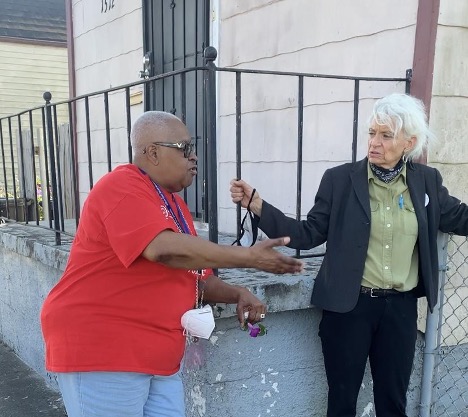 Community lead Beth Butler and resident Debra Campbell stand at the corner at the site of a future bioswale and affordable housing in New Orleans’ 8th Ward. The planned design integrates native plant gardens and private outdoor space to promote residents’ physical and mental health as part of the Thriving Earth projects Designing Bioswales for Improved Air Quality, Serenity and Reduced Flood Risk and Assessing Flooding and Hydrodynamics for Community Revitalization.
Community lead Beth Butler and resident Debra Campbell stand at the corner at the site of a future bioswale and affordable housing in New Orleans’ 8th Ward. The planned design integrates native plant gardens and private outdoor space to promote residents’ physical and mental health as part of the Thriving Earth projects Designing Bioswales for Improved Air Quality, Serenity and Reduced Flood Risk and Assessing Flooding and Hydrodynamics for Community Revitalization.
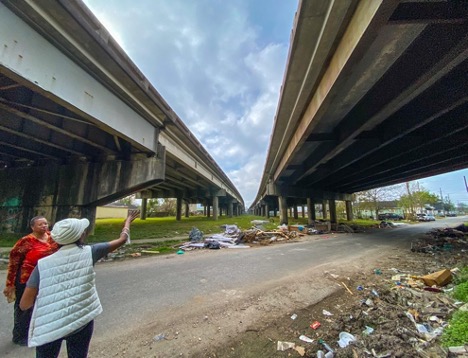 Community leads Amy Stelly and Tamah Yisrael pointing out the I-10 corridor in the 7th Ward, New Orleans. Their organization, Claiborne Avenue Alliance, worked with Thriving Earth Exchange to evaluate the impacts of Highway I-10 that runs above Claiborne Avenue. Their work contributed to a national conversation with New Orleans at its center.
Community leads Amy Stelly and Tamah Yisrael pointing out the I-10 corridor in the 7th Ward, New Orleans. Their organization, Claiborne Avenue Alliance, worked with Thriving Earth Exchange to evaluate the impacts of Highway I-10 that runs above Claiborne Avenue. Their work contributed to a national conversation with New Orleans at its center.
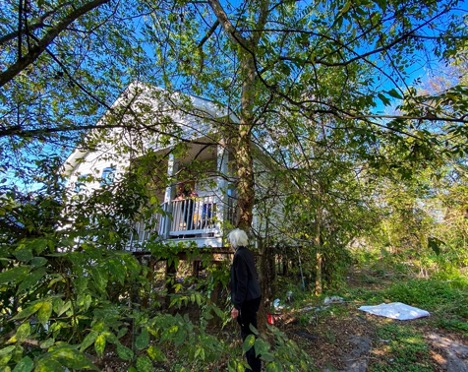 Visiting flood-affected homes in the 9th Ward, New Orleans, with community lead Beth Butler. Raising homes on stilts like this protects them from floods; the lot next door will be developed into a rain garden and bioswale to provide further flood protections and beautify the neighborhood.
Visiting flood-affected homes in the 9th Ward, New Orleans, with community lead Beth Butler. Raising homes on stilts like this protects them from floods; the lot next door will be developed into a rain garden and bioswale to provide further flood protections and beautify the neighborhood.
Community Leads
Amy Stelly and Tamah Yisrael, represent the leadership of the Claiborne Ave. Alliance. Claiborne Ave. Alliance members, Emily Gaddis and Margaret Thomas, are also involved to provide their knowledge of local environmental issues and the local healthcare system.
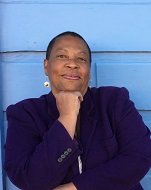
Amy Stelly serves the New Orleans community as an advocate for the redevelopment of the Claiborne Corridor. She has advocated for water safety and water management, written about the value of public engagement, lectured on community garden design, and the history of open space in Treme.
Amy is an artist, designer, and planner. Her body of work includes architectural and urban design, along with abstract painting, drawing, mask-making, photography, mixed-media and three-dimensional construction. As a designer and planner, her scope of work includes building and open space design, historic restoration, downtown and neighborhood revitalization, environmental planning, municipal zoning, incentives, entitlements, site planning, streetscapes and gardens. She has also led collaborative projects and taught integrated arts to a variety of students including autistic, gifted, main-stream and incarcerated youth.

Tamah Yisrael is the Executive Director of Builders of the Highway Foundation, a national non-profit. Through her leadership the Foundation has successfully merged the Neo Jazz School of Music under its umbrella and developed the Tombar Life Center. Yisrael is a business owner and community advocate and dedicated to providing education and opportunity through music and the arts. Her previous professional experience includes hospitality business management, chief financial officer, controller, paralegal, and bookkeeper.

Emily K. Gaddis, M.A., is a social entrepreneur, educator, intercultural trainer, and eco artist. As a trained curriculum developer, she applies an interdisciplinary approach to environmental education with attention to empowering communities to reduce their exposure to chemicals of concern and inspire others to lead positive lives.
Her journey in sustainable business operations began in 2015, and within the first six months, she won seven of eight live business pitch contests, secured start up funding exclusively through grants, and completed business accelerator Cleantech Open. In 2016 she co-founded the first natural wine shop in Louisiana, Spirit Wine. By re-designing operations, Spirit Wine eliminated over 90% of its waste, switched to clean energy, and formed strategic partnerships to recycle all product packaging. Having tested the waters of operating a triple bottom line business, her main mission in life is to collaborate with business, community, and government to bring the circular economy to the South and create a strong network of green collar jobs.
Scientific Liaisons

Dr. Adrienne Katner is an Assistant Professor at Louisiana State University-Health Science Center’s School of Public Health in the Environmental and Occupational Health Program. Prior to entering academia, Dr. Katner worked at the National Cancer Institute’s Occupational and Environmental Epidemiology Branch, where she conducted exposure assessments for a nationwide non-Hodgkin lymphoma study; and at the Louisiana Office of Public Health (LOPH), where she oversaw several statewide environmental health programs.
Dr. Katner’s research garnered national attention in the aftermath of Flint, Michigan, as her results and findings highlighted problems with drinking water regulations and prevailing guidelines to reduce exposure to lead from drinking water. She has used her research to propel policy changes and government action, including: a statewide policy change by LOPH to require water testing during home inspections of lead-poisoned children; a follow-up state investigation and confirmation of a significant lead in water crisis in the town of St. Joseph, LA, which resulted in a Public Health Emergency Proclamation, and state replacement of the town’s corroding drinking water infrastructure; and triggering an New Orleans Office of Inspector General report, which raised awareness of an “imminent risk” to residents from lead spikes in water after partial lead service line replacements.
Dr. Katner received a Bachelors in Molecular, Cellular and Developmental Biology from the University of California at Santa Cruz; a Masters in Soil, Water and Environmental Science from the University of Arizona; a Doctorate in Environmental Science and Engineering from the University of California at Los Angeles; and “Katrina Hero for Environmental Justice” and “Community Angel” awards from local non-profits for her work to increase awareness of lead in water hazards and cost-effective exposure prevention solutions.

Dr. Kari Fitzmorris Brisolara is an Associate Professor of Environmental and Occupational Health Sciences at the LSU Health Sciences Center, School of Public Health in New Orleans, Louisiana. She received her BS in Biology and Physics from Louisiana College, MSPH and Doctor of Science degrees in Environmental Health Sciences from Tulane University, School of Public Health and Tropical Medicine. After Tulane, she accepted a post-doctoral appointment with the United States Department of Agriculture – Agriculture Research Service where she spent two years focused on the development of activated carbon from agricultural residuals. In addition to research and continuing education programs, she has also participated in community-based projects related to migrant worker health in Georgia, the development of congressional position statements on aspects of the Farm Bill, and is a returned Peace Corps Volunteer.
ISeeChange is dedicated to empowering communities to document and understand their environment, weather and climate in order to increase resilience. ISeeChange mobilizes communities to share stories and micro-data about climate impacts to inform and improve climate adaptation and infrastructure design. Their platform, tools, and investigations provide equitable, iterative ways for residents to personalize, measure, and track climate change impacts and better participate in community adaptation decisions.
Each post is synced with weather and climate data and broadcast to the community to investigate bigger picture climate trends. Over time, community members can track how climate is changing, season to season, year to year, and understand the impacts on daily life.
ISeeChange is a strategic partner of Thriving Earth Exchange as community members use their platform and tools to better characterize, visualize, and communicate neighborhood-level climate trends and co-develop solutions to mitigate those risks.

(c) 2024 Thriving Earth Exchange